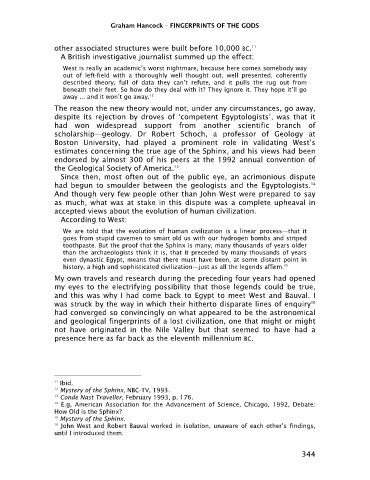Page 346 - Fingerprints of the Gods by Graham Hancock
P. 346
Graham Hancock – FINGERPRINTS OF THE GODS
other associated structures were built before 10,000 BC.
11
A British investigative journalist summed up the effect:
West is really an academic’s worst nightmare, because here comes somebody way
out of left-field with a thoroughly well thought out, well presented, coherently
described theory, full of data they can’t refute, and it pulls the rug out from
beneath their feet. So how do they deal with it? They ignore it. They hope it’ll go
away ... and it won’t go away.
12
The reason the new theory would not, under any circumstances, go away,
despite its rejection by droves of ‘competent Egyptologists’, was that it
had won widespread support from another scientific branch of
scholarship—geology. Dr Robert Schoch, a professor of Geology at
Boston University, had played a prominent role in validating West’s
estimates concerning the true age of the Sphinx, and his views had been
endorsed by almost 300 of his peers at the 1992 annual convention of
the Geological Society of America.
13
Since then, most often out of the public eye, an acrimonious dispute
had begun to smoulder between the geologists and the Egyptologists.
14
And though very few people other than John West were prepared to say
as much, what was at stake in this dispute was a complete upheaval in
accepted views about the evolution of human civilization.
According to West:
We are told that the evolution of human civilization is a linear process—that it
goes from stupid cavemen to smart old us with our hydrogen bombs and striped
toothpaste. But the proof that the Sphinx is many, many thousands of years older
than the archaeologists think it is, that it preceded by many thousands of years
even dynastic Egypt, means that there must have been, at some distant point in
history, a high and sophisticated civilization—just as all the legends affirm.
15
My own travels and research during the preceding four years had opened
my eyes to the electrifying possibility that those legends could be true,
and this was why I had come back to Egypt to meet West and Bauval. I
was struck by the way in which their hitherto disparate lines of enquiry
16
had converged so convincingly on what appeared to be the astronomical
and geological fingerprints of a lost civilization, one that might or might
not have originated in the Nile Valley but that seemed to have had a
presence here as far back as the eleventh millennium BC.
11 Ibid.
12 Mystery of the Sphinx, NBC-TV, 1993.
13 Conde Nast Traveller, February 1993, p. 176.
14 E.g, American Association for the Advancement of Science, Chicago, 1992, Debate:
How Old is the Sphinx?
Mystery of the Sphinx.
15
16 John West and Robert Bauval worked in isolation, unaware of each other’s findings,
until I introduced them.
344

